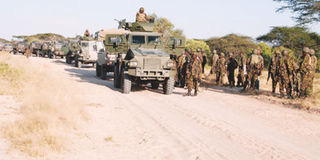Who will fill Al-Shabaab void after exit of Kenyan soldiers?

Photo/FILE
A convoy of the Kenya Defence Forces on its way to Afmadhow from Beliis Quuqani.
The Kenyan military appears well on its course to clearing Al-Shabaab from the strongholds near the border that the militants have held since 2006.
But the question which hangs over the whole enterprise is: Who will fill the void left by Al-Shabaab?
Are the administrations being installed in the areas liberated from the militants strong enough to resist the militants once Kenyans pull out?
And what is Kenya’s long-term objective when its surprise incursion into Somalia comes to an end?
A tour of the areas from which the Shabaab have been pushed out and interviews with local players offers a broad outline of the central idea behind the military offensive.
The mission — long denied by Kenya — is to create a semi-autonomous zone similar to Puntland in much of southern Somalia, from which the Shabaab cannot operate with a free hand near Kenya’s border.
Under this vision, the region would be controlled by whomever the elders of the dominant Mohamed Zuber clan pick to be their leader.
That leadership would head a government of a federal unit near the Kenyan border, with its headquarters in Kismayu. It is a strategy that carries both risks and benefits.
Kenya appears to have succeeded in luring to its side some of the key power players in southern Somalia, especially the former Islamic Courts Union chief in the region, Sheikh Ahmed Madobe, and one of the main generals in the Somali National Army, Brig Gen Ismael Sahardid.
But this approach is likely to face resistance from whoever emerges as the president of the whole of Somalia once elections are held at the end of the transitional period in August.
That could raise the spectre of conflict between the centre and the emerging semi-autonomous regions such as the one in the south and others that exist such as Galmudug and Puntland further north.
To adopt federalism
According to Sheikh Madobe, the head of Ras Kamboni Brigade, which has been fighting alongside the Kenyans, there is no alternative but for Somalia to adopt federalism.
“We have fought for 24 years because of the problems that began in Mogadishu. I don’t think we will now go back to absolute central control by Mogadishu.
“We can have a central government there but with majimbo that allows people to make their own decisions.”
Brig Gen Sahardid sounds a more cautious note. He says Somalia’s problems began when people felt that resources were being dominated by Mogadishu.
But he says the question of the degree of federalism Somalia will adopt should be left to the constitution drafters.
If the south comes into confrontation with Mogadishu, it would mean that Kenya by extension could be sucked into a wider conflict. The most important question for the Kenyan security establishment is what becomes of Al-Shabaab.
History suggests few groups that embrace terrorism and unconventional warfare have been defeated through purely military means in the last few decades.
The only exception to the rule might be the Tamil Tigers, which waged a violent secession war from 1983 until they were defeated by the Sri Lankan army in 2002.
Other confrontations with militant extremists have ended in untidy compromises. In Iraq, the US was facing a long, bloody war against Al-Qaeda until the “Anbar Awakening” where local Sunnis got fed up with the group’s tactics such as large-scale suicide bombings and turned against the Al-Qaeda fighters.
In Chechnya, the Russians dealt with the bloody separatist campaign by rebels in that territory by co-opting one of the leading rebels, Akhmad Kadyrov, who imposed order in the Caucasus. He was assassinated in 2004 and succeeded by his son, Ramzan Kadyrov.
What will be the future of Al-Shabaab? Prediction by some military sources, who sought anonymity, is that they will break into smaller groups that will attempt to regroup in neighbouring countries such as Kenya, Yemen and Somaliland.
This process is already under way with reports that some senior Al-Shabaab leaders have crossed into Yemen.
From there, it is expected they will attempt to stage terror attacks in the region, operating in sleeper cells much as they did before they became a well-known force in 2006.
That means countries such as Kenya will have to redouble their efforts to tackle extremism.
In the short-term, the Kenyans plan to continue with their strategy of moving forward progressively, building up new administrations in each area they move into.
The projection is that the Kenyan withdrawal will pave the way for a peace-keeping force stationed in former Al-Shabaab strongholds in Somalia.




